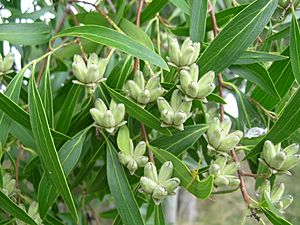Quillaja brasiliensis facts for kids
Quick facts for kids Quillaja brasiliensis |
|
|---|---|
 |
|
| Scientific classification | |
| Genus: |
Quillaja
|
| Species: |
brasiliensis
|
Quillaja brasiliensis is a fascinating plant that belongs to the Quillaja genus. It is a tree or shrub that naturally grows in Brazil. This plant is known for some special properties, especially in its bark, which has been used for various purposes over time.
Contents
About Quillaja brasiliensis
Quillaja brasiliensis is a type of plant that is native to South America, specifically Brazil. It is part of the Quillaja family, which includes a few different species. These plants are often found in specific environments, like certain forests or areas with particular soil types.
What Does It Look Like?
Quillaja brasiliensis can grow as a small tree or a shrub. Its leaves are usually simple and green. The plant produces flowers, which then turn into fruits. The most interesting part of this plant, however, is often its bark. The bark contains special compounds that make it useful.
Where It Grows Naturally
This plant is found in various regions across Brazil. It prefers certain climates and soil conditions to grow best. Understanding where a plant naturally grows helps scientists learn about its needs and how it fits into its ecosystem. The native habitat of Quillaja brasiliensis is important for its survival.
Interesting Uses of Quillaja
Some plants in the Quillaja genus, including Quillaja brasiliensis, are known for containing natural substances called saponins. Saponins are compounds that can create a foamy lather when mixed with water, much like soap. Because of this, the bark of these plants has traditionally been used as a natural soap. People would use it for washing clothes or even as a shampoo.
Traditional Uses
Long ago, people in the regions where Quillaja plants grow discovered their unique properties. They learned how to prepare the bark to extract the saponins. This natural soap was a valuable resource for cleaning. It shows how people used the plants around them to meet their daily needs.
Modern Applications
Even today, saponins from Quillaja plants are used in different ways. They can be found in some products as natural foaming agents. Scientists also study these compounds for their potential uses in medicine and other fields. It's amazing how a plant can have so many different applications!
How Quillaja Reproduces
Like most flowering plants, Quillaja brasiliensis reproduces through seeds. Flowers on the plant are pollinated, which leads to the development of fruits containing seeds. These seeds then fall to the ground and, if conditions are right, can grow into new plants. This process ensures the survival of the species.
Life Cycle of the Plant
The life cycle of Quillaja brasiliensis begins with a seed. The seed germinates and grows into a seedling. Over time, the seedling matures into an adult plant, which then produces its own flowers and seeds. This cycle continues, allowing the plant to spread and thrive in its natural environment.
See also
 In Spanish: Árbol del jabón para niños
In Spanish: Árbol del jabón para niños

